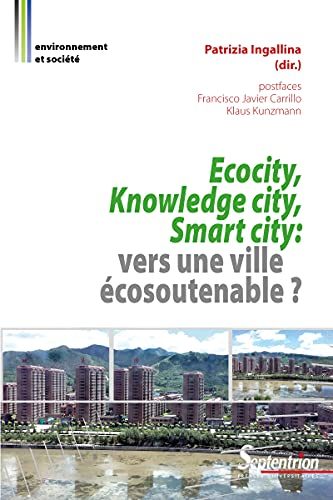Reference
WUP. (2018). World urbanization prospects: The 2018 revision. UN-DESA. Retrieved from https://population-un-org.libproxy.ucl.ac.uk/wup/ [Google Scholar]

Reviewed by Gabriel Camară
According to United Nations estimates, the percentage of the 2020 population that is urban is 56.2%, and by 2050, it will be 68.4%; this growth is projected to be spectacular, especially in less-developed countries (WUP, 2018). Therefore, the concern of academics and policy makers regarding the sustainability of cities is natural, especially since currently, as specified in this book, the urban environment faces a number of different challenges: rapid urbanization, pressure on natural resources, climate change, the risk of terrorism and its consequences on social cohesion, the growth of inequalities, and the impact of pollution linked to human activities both on the environment and on health.
This book, published in French, is rooted in the French sustainability literature. It is an edited volume produced from an international research seminar organized by Sorbonne University under the supervision of Professor Patrizia Ingallina; it is part of the theme of urban sustainability, and its intention is to explore the principle of ecological innovation in the complex situation of cities. Without claiming to give all the answers, the merit of this book is that it tries to integrate into a single book the problems and complexities of urban sustainability and resilience that are usually treated separately.
The purpose of the book is “to outline the challenges and opportunities presented by the city of the future which aims to be knowledge-based, smart and, in a word, eco-sustainable” (p. 24). The book launches the idea that the city of the future must be eco-sustainable, and the authors seek to argue this hypothesis. The book accomplishes its goals and advances our understanding of urban sustainability because the authors, through research and empirical studies, correlate some issues to obtain a version of the eco-sustainable city. Such a city should be a less polluted and a low-carbon city with more biodiversity and natural green spaces; it should promote sustainable mobility and transportation by adopting strategies involving energy transition, and it should reconcile innovation and heritage with both the integration of the knowledge city paradigm and with new dealings between public and private actors who have responsibilities in urban planning.
It is to be appreciated that in this book, the eco-city is not treated as a simple theoretical concept but rather involves concrete situations, such as inhabitants’ health and environmental protection: “The urban policies must develop multiple and diverse actions, the most urgent of which concern public health and environmental protection” (p. 24). This principle is also taken into account by international organizations, such as the United Nations, and by many other studies.
In the introduction, Professor Ingallina presents a welcome and complex overview of the main concepts that are also found in the title of the book, in addition to the concepts of innovation, competitiveness, attractiveness, and digital societies, all of which lead to a sustainable city. “Smart-city and knowledge-city essentially underline the technological and innovative character that the current city should have. The concept of eco-city, on the other hand, an ‘eco-sustainable city’, is presented as the most complete because it appeals, in addition to the technological dimension, also to the ecological dimension” (p. 24).
The question of the city of the future calls for a pluralistic approach while maintaining focus on the city and its transformations. The book consists of thematically grouped chapters in five major parts, each chapter being written by different authors. Despite their different level of expertise (from experienced researchers to PhD students), their different scientific backgrounds, and the various aspects discussed, the book has a unitary character and contributes to the current debate on the sustainability of cities in societies in transition. According to the objective of the book, i.e., to show what an eco-sustainable city is, the five parts of the book address five issues that arise in creating an eco-sustainable city, namely, nature and environment, sustainable transport and mobility, positive energy, innovation and heritage, and smart- and knowledge-based cities. Although the parts of the book each address different topics, and the chapters in each part are also uniquely different, the chapters fit together to advance the general theme of the book. Finally, we can appreciate that every chapter, including the case studies, contributes to the debate concerning the challenges faced by actual urban environments and those faced when building the image of an eco-sustainable city. In addition, some concepts are defined in the foreword (the concept of resilience) and in the afterword (the knowledge markets and darker sides of smart city development).
The challenge of the city of the future is to reconcile development, sustainability and health (of both people and environment), and this book contributes to our understanding of urban sustainability not only by clarifying some concepts and presenting examples of good practices but also by presenting research that shows us that some initiatives do not reach all inhabitants (nature in the city, for example). This book is worth reading because it addresses a diverse topic in the field of urban sustainability and contains both advanced research and introductory aspects and definitions that have applicability in the field of education; it also builds an image of the eco-sustainable city for both specialists and those who are not familiar with this field.
The references at the end of each chapter contribute significantly both to the understanding of the text and, where appropriate, to the engagement of new reflections. While the public to whom this book is addressed is not specified, the content is well structured, and the text is easy to read, being illustrated with maps, tables, schemes, and photos from the cities discussed in the case studies, thus making it accessible to several categories of readers, including researchers, students, practitioners, policy makers, and the general public.
Reference
WUP. (2018). World urbanization prospects: The 2018 revision. UN-DESA. Retrieved from https://population-un-org.libproxy.ucl.ac.uk/wup/ [Google Scholar]